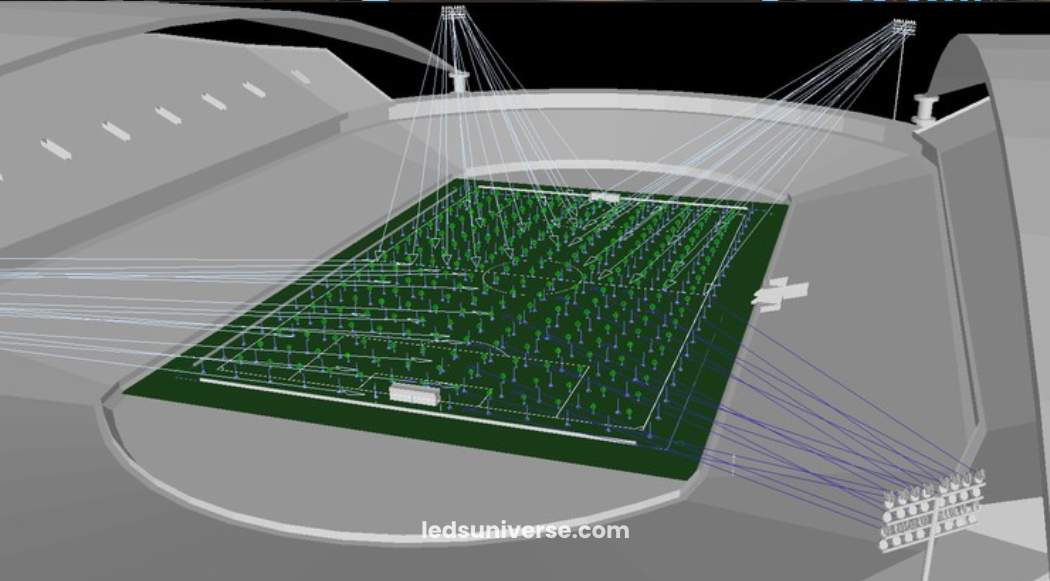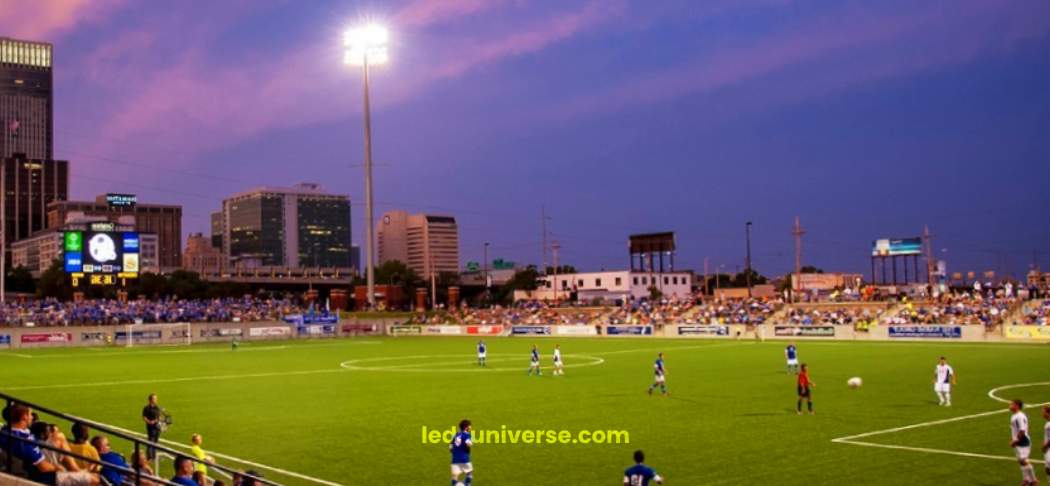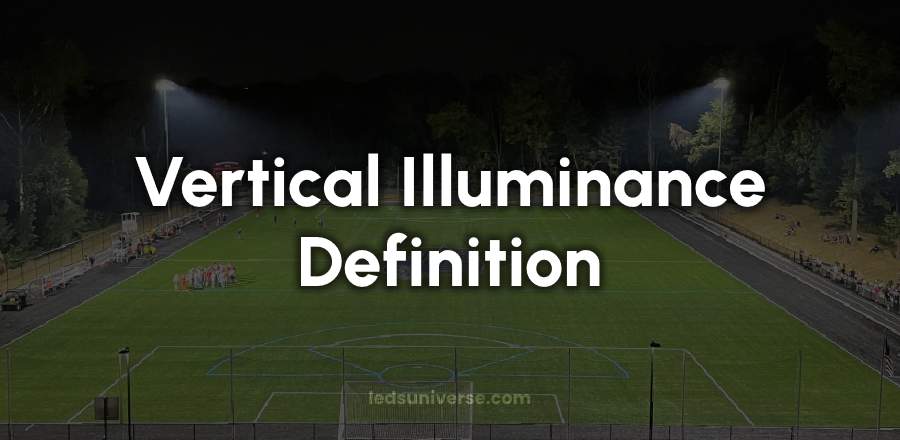Illuminance is a fundamental concept in lighting design, specifically measuring how much light illuminates a given surface. Vertical illuminance is particularly relevant in contexts where light is perceived by cameras and the human eye as it reflects off various surfaces. This measurement is expressed in lux, a unit that quantifies the intensity of light as perceived by the average observer. This metric plays a crucial role in the planning and execution of lighting in sports, where visual clarity is paramount during televised events.
Table of Contents
ToggleUnderstanding Vertical and Horizontal Illuminance
When discussing illuminance in the realm of sports, it is essential to distinguish between two primary types of measurements: horizontal illuminance and vertical illuminance.
Horizontal Illuminance
Horizontal illuminance refers to the measurement taken on a horizontally positioned hypothetical surface located approximately one meter above the ground. This measurement involves multiple calculations performed on a grid that covers the playing area. The goal is to ensure that the playing surface is adequately lit for players, spectators, and broadcasting. This illuminance is critical for safety, performance, and enjoyment during sporting events.
Vertical Illuminance
In contrast, vertical illuminance is measured on a hypothetical surface oriented vertically. This difference means that both the position and orientation of the surface must be specified. Vertical illuminance can be directed towards specific audience areas or focused in the direction of camera angles. This consideration is particularly relevant in sports, where various viewpoints must be accounted for to optimize visibility for both in-person spectators and television viewers.

Calculation of Illuminance with LED Sports Lights
When assessing lighting in sports venues, it is vital to consider both the principal playing area and the total area, which encompasses not only the playing surface but also safety zones. In this context, lighting is typically measured in terms of minimum horizontal illuminance and the uniformity of that illuminance across the field. The quality of luminance in sports arenas is critical since the illuminated surfaces must be easily visible to all viewers, whether they are present at the event or watching from home.
The Role of LED Sports Lighting
LED lighting technology has gained significant traction in sports due to its efficiency and effectiveness. With the growing need for better visibility in large sports arenas, efficient lighting systems become indispensable. The use of LED lights allows for a more uniform distribution of light across the playing area, ensuring that both players and spectators can enjoy a well-lit environment.
The Importance of Uniformity in Lighting
Uniformity in lighting is essential not only for aesthetic reasons but also for safety and performance. Inadequate lighting can lead to accidents, hinder player performance, and detract from the viewing experience. In sports that are televised, ensuring that all angles of the playing field are adequately illuminated is crucial for maintaining a high standard of broadcast quality.
Detailed Examination of Vertical and Horizontal Light Measurement
Vertical lighting is typically reserved for high-profile stadium installations that require top league standards, especially those with regular broadcasting in high-definition or 4K formats. In many cases, even professional sports in lower leagues may not implement vertical lighting systems, as their games are not frequently televised.
Cost Implications of Vertical Lighting
Integrating vertical lighting into a sports venue can significantly increase project costs. Vertical lighting often requires adjustments tailored to the broadcasting needs of cameras, which can elevate the project’s expense by an average of 70% compared to standard horizontal configurations. This increase in cost stems from the need for additional fixtures and energy usage, as the lighting must cater to various angles that enhance the visual experience for viewers.
Projects focusing on vertical lighting generally necessitate purchasing nearly double the number of light fixtures compared to those relying solely on horizontal illuminance. Consequently, for venues operating below a lux level of 1,000, vertical lighting is typically not justified. However, for top-tier stadiums aiming for a minimum of 1,200 lux, the demand for vertical lighting becomes a factor in planning.
The Application of High Mast Lights in Sports Venues
High mast lighting is often employed in larger sports venues, such as those used by FIFA and UEFA. These installations require precise planning and execution to meet the visual demands of both live audiences and broadcast viewers. The proper positioning and orientation of lights are vital in achieving the desired illumination levels and ensuring uniformity throughout the playing area.

Calculating Vertical Illuminance with LED Sports Lights
Luminance is quantitatively measured in SI units, specifically in lux (lx), which translates to lumens per square meter. This measurement defines the intensity and distribution of light across a given area. The common symbol used to denote illuminance is Ev.
The Role of Vertical Illuminance in Sports
Vertical illuminance holds significant relevance in sports due to its impact on viewer perception and judgment. In games such as football and basketball, where critical components like goalposts and baskets are positioned vertically, measuring vertical illuminance becomes integral.
To accurately assess vertical illuminance, a standard equation is employed: Ev = (1/d²) * sin y, where “d” represents the distance from the light source to the vertically illuminated surface, and “y” denotes the angle between the lighting system and the surface. This mathematical framework is essential for understanding how light interacts with various surfaces and ensures that both players and spectators have an optimal viewing experience.
Utilizing Lighting Software for Accurate Measurement
Advanced lighting design software, such as DIALux, is commonly used to perform calculations for both vertical and horizontal light measurements. This software enables designers and engineers to simulate different lighting scenarios, facilitating informed decision-making regarding the placement and orientation of light fixtures. By leveraging these tools, sports lighting professionals can avoid improper viewing angles and enhance visibility across the entire venue.
Consulting a Lighting Specialist
When embarking on a project to optimize vertical and horizontal light measurements, seeking the expertise of a lighting specialist can provide invaluable insights. A dedicated research and development team, like the one at LedsUniverse, can assist in navigating the complexities of lighting design, ensuring that the chosen system aligns with the specific requirements of the venue.
The Benefits of Collaborating with Experts
Consulting with lighting professionals is particularly beneficial for projects involving advanced lighting systems such as LED sports lights. These specialists possess the knowledge and experience necessary to evaluate the vertical illuminance requirements and recommend appropriate solutions tailored to the venue’s unique needs.
Leveraging LED Technology for Optimal Performance
LED systems present numerous advantages in sports lighting, offering a wide array of possibilities to enhance viewer experience. By consulting experts, venue managers can ensure that lighting systems are optimized for both performance and cost-effectiveness. The deployment of LED lighting can lead to reduced energy consumption, longer lifespans for fixtures, and improved overall illumination quality.
Conclusion
With a solid understanding of the principles behind these measurements, venue managers can make informed decisions regarding lighting systems that not only enhance visibility but also align with broadcasting requirements. By leveraging modern LED technology and collaborating with lighting specialists, sports facilities can achieve a high standard of illumination, ensuring that every game is presented in its best light.
